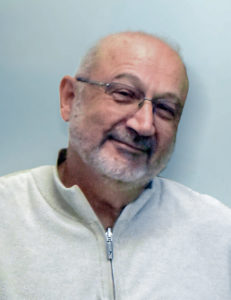Research & Publications
Theodoros Sklaviadis dedicated the biggest part of his scientific career into studying the pathology of prion diseases. Prion diseases are fatal neurodegenerative disorders caused by the accumulation of a misfolded protein, the prion protein. Due to its misfolded structure, it is capable of forming aggregates in the central nervous system of mammals, leading to neurological symptoms, both motor and cognitive. The exact mechanism of the conformational change from a normal protein to pathogen is still obscure.
Although human prion diseases are rare nowadays, research on them is still considered valuable, not only because of the risk of a new epidemic that could be transmitted to humans from animals (like mad cow’s disease), but also because of the similarity of the mechanism with other proteinopathies (diseases caused by the accumulation of misfolded proteins), such as Alzheimer’s, Parkinson’s and Multiple Sclerosis.
Over the years, Theodoros Sklaviadis has studied various proteinopathies through cellular and animal models for the developement of pharmaceuticals and immunotherapies against them. Lately, he has been interested in the role of RNA Editing in their progression and how the basic RNA Editing genes ADAR and APOBEC could affect the neurodegeneration progress.
Selected Publications
A physicochemical model for rationalizing SARS-CoV-2 concentration in sewage. Case study: The city of Thessaloniki in Greece.
Detection of SARS-CoV-2 in sewage has been employed by several researchers as an alternative early warning indicator of virus spreading in communities, covering both symptomatic and asymptomatic cases. A factor that can seriously mislead the quantitative measurement of viral copies in sewage is the adsorption of virus fragments onto the highly porous solids suspended in wastewater, making them inaccessible. This depends not only on the available amount of suspended solids, but also on the amount of other dissolved chemicals which may influence the capacity of adsorption. On this account, the present work develops a mathematical framework, at various degrees of spatial complexity, of a physicochemical model that rationalizes the quantitative measurements of total virus fragments in sewage as regards the adsorption of virus onto suspended solids and the effect of dissolved chemicals on it. The city of Thessaloniki in Greece is employed as a convenient case study to determine the values of model variables. The present data indicate the ratio of the specific absorption (UV254/DOC) over the dissolved oxygen (DO) as the parameter with the highest correlation with viral copies. This implies a strong effect on viral inaccessibility in sewage caused (i) by the presence of humic-like substances and (ii) by virus decay due to oxidation and metabolic activity of bacteria. The present results suggest days where many fold corrections in the measurement of viral copies should be applied. As a result, although the detected RNA load in June 2020 is similar to that in April 2020, virus shedding in the city is about 5 times lower in June than in April, in line with the very low SARS-CoV-2 incidence and hospital admissions for COVID-19 in Thessaloniki in June.
Application of antibody phage display to identify potential antigenic neural precursor cell proteins
Paspaltsis, I., Kesidou, E., Touloumi, O., Lagoudaki, R., Boziki, M., Samiotaki, M., Dafou, D., Sklaviadis, T., & Grigoriadis, N. (2020). Application of antibody phage display to identify potential antigenic neural precursor cell proteins. Journal of biological research (Thessalonike, Greece), 27, 14. https://doi.org/10.1186/s40709-020-00123-4
Abstract
Background
The discovery of neural precursor cells (NPCs) and the concomitant intensive research in the field offer regenerative medicine novel approaches, enabling it to tackle conditions, such as neurodegenerative diseases. Transplantation of NPCs is nowadays considered a cutting-edge treatment for these conditions and many related clinical trials have been already completed or are still ongoing. However, little is known about the antigenicity of NPCs, with most studies addressing the question whether their antigenicity could lead to rejection of the transplanted cells.
Results
In this study we investigated the antigenic potential of syngeneic NPCs emulsion, upon subcutaneous (s.c.) administration to wild type C57BL/6 mice, following a standard immunization protocol. The whole IgG repertoire expressed upon immunization was cloned into a Fab phage display vector. From the created phage display library, Fab expressing clones interacting with NPCs lysate proteins were selected with the biopanning technique. The IgG Fab fragment from clone 65 proved to be reactive against antigens originating from NPCs lysates and/or whole brain lysate in diverse immunological assays.
Conclusions
Using a standard immunization protocol to administer NPCs antigens, and applying the Fab fragment phage display technique, we were able to isolate at least a monoclonal IgG Fab fragment, which interacts with different mouse brain proteins. It is not clear whether such antibodies are produced in the host organisms, following NPCs transplantation.
Characterization of goat prions demonstrates geographical variation of scrapie strains in Europe and reveals the composite nature of prion strains
For more publications
Current Projects
Developement and Application of a novel system for the Photocatalytic Inactivation of hazardous medical liquid waste containing toxic pollutants and/or pathogens (PhotoInact)
Development of improved biomarker technologies for the discriminative diagnosis of Parkinson disease
Prof. Theodoros Sklaviadis
Office
+302310997615, +302310997720
Laboratory
+302310997637, +302310997664
Fax
2310997720
Office Address
310 (3rd Floor), School of Pharmacy
Aristotle University of Thessaloniki
University Campus, 54124
Thessaloniki, Greece
Office hours: (Arrange your appointment via e-mail)
This site is created by Dimitra Paschaloudi.

